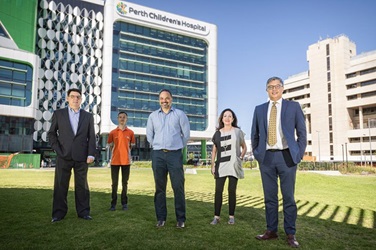New Rare Care Centre will coordinate rare disease care at Perth Children’s Hospital

Rare Care Centre: Carrick Robinson (PCHF), Andrew Bannister, Dr Gareth Baynum, Sue Baker, Dr Aresh Anwar (CAHS CE)
Western Australia is taking a global leading role in establishing a Rare Care Centre that will provide a holistic model of care for children with rare and undiagnosed diseases.
Based at PCH, the Centre has secured funding from leading WA philanthropists – the Angela Wright Bennett Foundation, the McCusker Charitable Foundation via the Channel 7 Telethon Trust, the Stan Perron Charitable Foundation and the Perth Children’s Hospital Foundation via a significant contribution from Mineral Resources Limited. Together they have provided a total commitment of $10m over 5 years, starting from July 2022.
The Centre will deliver improved awareness and early identification of children with potential rare diseases and enhanced referrals to support earlier and more accurate
diagnosis. It will also provide improved support and care coordination; and better access to community resources, clinical trials and research.
The Centre will also focus on Aboriginal health and mental health, connecting the child and their families with a wider range of services, such as education and disability services.
Funding from donors will help establish the development of an education centre, global partnerships, research collaborations, support programs and advocacy for rare and undiagnosed diseases.
Clinical geneticist and Centre Medical Director, Dr Gareth Baynam said the aim is to improve the lives of children and young people living with a rare disease and their families by providing a holistic and globally connected model of care.
“Although they are called ‘rare’, cumulatively the impact of rare diseases is massive,” Dr Baynam said.
“There are more than 60,000 children and young people living with a rare disease in WA, which is enough to fill Optus Stadium.
“This is an area of such severe and large unmet need; rare and undiagnosed diseases are like a hidden, global endemic.”
He also said children and adolescents and their families living with rare and undiagnosed diseases are on two journeys.
“Firstly, just attaining a diagnosis is distressing and complex. On average it takes five years to get a diagnosis for a child with a rare disease,” Dr Baynam said.
“That’s five years of uncertainty, mental distress and isolation. Second, is the care journey. Only six per cent of rare diseases have a specific drug treatment. However, 100 per cent of children living with rare diseases can have improved lives through better coordination of medical care across specialties, and better integration across sectors.”
Dr Aresh Anwar, Child and Adolescent Health Service Chief Executive said:
“I’d like to acknowledge the critical role of the donors in helping to enhance the services we are able to provide to some of our most vulnerable children and their families. It is through collaborations like this that we are able to drive real innovation in how we support children living with rare and undiagnosed diseases.
“For the families of children living with a rare or undiagnosed disease, knowing there is a dedicated centre that aims to provide a comprehensive and coordinated treatment plan and deliver access to a global network of specialists and families living with the same diagnosis, is a game changer.”
The Centre will work with world-leading rare diseases experts, including the World Health Organisation Global Network for Rare Diseases.